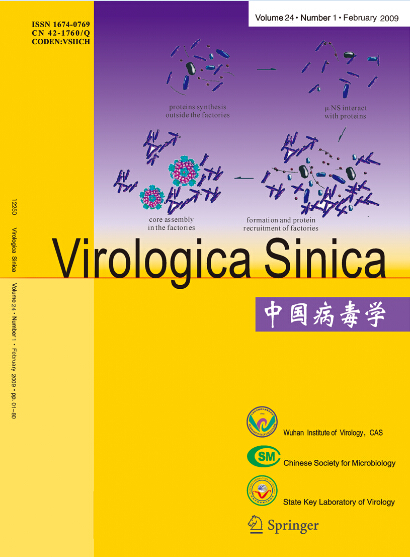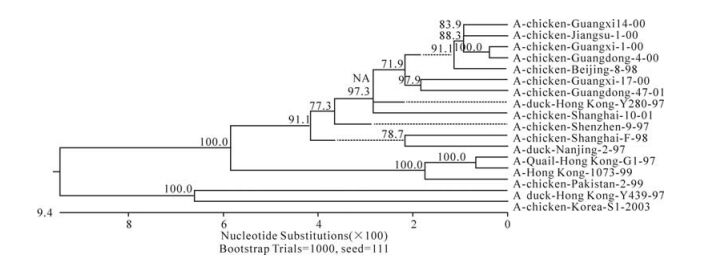-
Alexander D J. 1982. Avian influenza: recent develop-ments. Veter Bull, 52 (6): 341-359.
-
Butt K M, Smith G J D, Chen H, et al. 2005. Human infection with an avian H9N2 influenza A virus in Hong Kong in 2003. J Clin Microbiol, 43 (11): 5760-5767.
doi: 10.1128/JCM.43.11.5760-5767.2005
-
Choi Y K, Ozaki H, Webby R J, et al. 2004.Continuing evolution of H9N2 influenza viruses in southeastern China. J Virol, 78 (16): 8609-8614.
doi: 10.1128/JVI.78.16.8609-8614.2004
-
Guan Y, Shortridge K F, Krauss S, et al. 2000.H9N2 influenza viruses possessing H5N1-like internal genomes continue to circulate in poultry in southeastern China. J Virol, 74 (20): 9372-9380.
doi: 10.1128/JVI.74.20.9372-9380.2000
-
Guo Y J, Krauss S, Senne D A, et al. 2000. Charac-terization of the pathogenicity of members of the newly established H9N2 influenza virus lineages in Asia. Virology, 267 (2): 279-288.
doi: 10.1006/viro.1999.0115
-
Kwon H J, Cho S H, Kim M C, et al. 2006. Molecular epizootiology of recurrent low pathogenic avian influenza by H9N2 subtype virus in Korea. Avian Pathol, 35 (4): 309-315.
doi: 10.1080/03079450600821166
-
Li K S, Xu K M, Peiris S M, et al. 2003. Characterization of H9 subtype influenza viruses from the ducks of southern China: a candidate for the next influenza pandemic in humans?. J Virol, 77 (12): 6988-6994.
doi: 10.1128/JVI.77.12.6988-6994.2003
-
Lin Y P, Shaw M, Gregory V, et al. 2000. Avian-to-human transmission of H9N2 subtype influenza A viruses: relationship between H9N2 and H5N1 human isolates. Proc Natl Acad Sci U S A, 97 (17): 9654-9658.
doi: 10.1073/pnas.160270697
-
Liu H, Liu X F, Cheng J, Peng D, et al. 2003. Phy-logenetic analysis of the hemagglutinin genes of twentysix avian influenza viruses of subtype H9N2 isolated from chickens in China during 1996-2001. Avian Dis, 47 (1): 116-127.
doi: 10.1637/0005-2086(2003)047[0116:PAOTHG]2.0.CO;2
-
Liu J H, Okazaki K, Shi W M, et al. 2003.Phylogenetic analysis of neuraminidase gene of H9N2 influenza viruses prevalent in chickens in China during 1995-2002. Virus Genes, 27 (2): 197-202.
doi: 10.1023/A:1025736829103
-
Lu J H, Liu X F, Shao W X, et al. 2005.Phylogenetic analysis of eight genes of H9N2 subtype influenza virus: a mainland China strain possessing early isolates' genes that have been circulating. Virus Genes, 31 (2):163-169.
doi: 10.1007/s11262-005-1790-1
-
Matrosovich M N, Krauss S, Webster R G. 2001. H9N2 influenza A viruses from poultry in Asia have human viruslike receptor specificity. Virology, 281 (2): 156-162.
doi: 10.1006/viro.2000.0799
-
Peiris M, Yuen K Y, Leung C W, et al. 1999. Human infection with influenza H9N2. Lancet, 354 (9182): 916-917.
doi: 10.1016/S0140-6736(99)03311-5
-
Steinhauer D A. 1999.Role of hemagglutinin cleavage for the pathogenicity of influenza virus. Virology, 258 (1): 1-20.
doi: 10.1006/viro.1999.9716
-
Wang S, Shi W M, Mweene A, Wei H L, et al. 2005. Genetic analysis of the nonstructural (NS) genes of H9N2 chicken influenza viruses isolated in China during 1998-2002. Virus Genes, 31 (3):329-335.
doi: 10.1007/s11262-005-3251-2
-
Webster R G, Bean W J, Gorman O T, et al. 1992. Evolution and ecology of influenza A viruses. Microbiol Reviews, 56 (1): 152-179.
-
World Health Organization. 1980. A revision of the system of nomenclature for influenza viruses: a WHO memorandum. Bull World Health Organ, 58 (40): 585-591.
-
Xie Z X, Pang Y S, Liu J B, et al. 2006.Amultiplex RT-PCR for detection of type A influenza virus and differentiation of avian H5, H7, and H9 hemagglutinin subtypes. Mol Cell Probes, 20 (3) :245-249.












